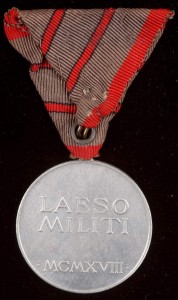The Wound Medal was instituted by Emperor Karl on 12 August 1917, though it was only issued in 1918, and was the last medal to be officially established in the Austro-Hungarian Empire. It was awarded to servicemen, regardless of rank, who were wounded in combat and to persons attached to the armed forces or who were invalided as a result of combat. In this way Emperor Karl wished to bestow recognition on a large category of persons who were not in a position to earn an award for merit or bravery.
The medal measured 38 mm in diameter and was made of a dull grey zinc alloy, though there are examples of polished surfaces. The obverse depicted the bust of Emperor Karl with his name in Latin CAROLVS above two crossed laurel branches bound together at their base. The name of the designer is visible between the bust and the laurel branches in small letters: R. PLACHT. The reverse bears the words LAESO MILITI (to the wounded soldier) and the date in MCMXVIII (1918).
The medal was suspended from a 39 mm wide grey tri-fold with red outer stripes. The number of wounds was indicated by narrower red stripes edged in black on the grey centre. No stripes indicated an award for someone invalided out of service. The maximum number of stripes was five, where wounds received during the same day/action counted as one. It was worn on the left breast.
Major Josef Kolbe was probably awarded the Wound Medal in 1918, after his return from captivity in Italy.
 |  |  Wound Medal, one stripe (3rd from right) |
Sources:
http://en.wikipedia.org/wiki/Wound_Medal_(Austria-Hungary)
https://de.wikipedia.org/wiki/Verwundetenmedaille_(Österreich-Ungarn)
http://www.austro-hungarian-army.co.uk/woundmed.htm
